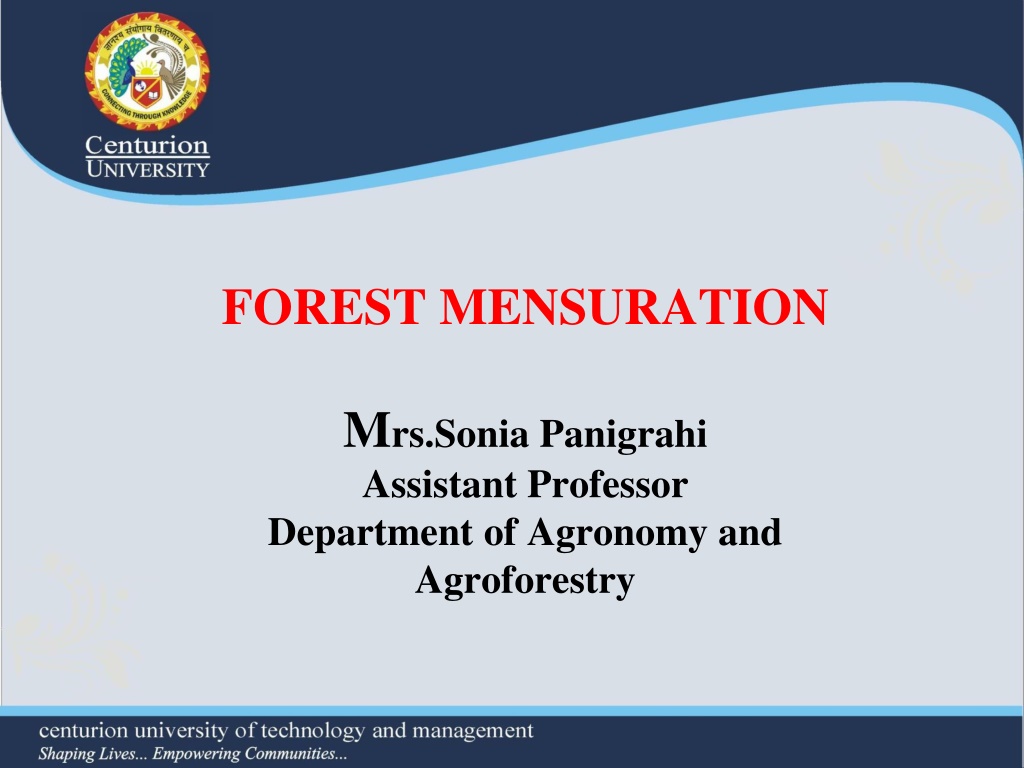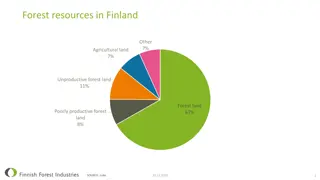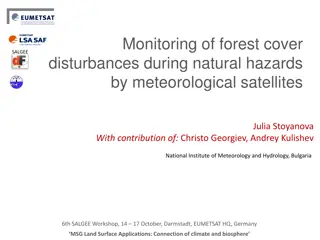Understanding Forest Mensuration Techniques and Measurements
Exploring the importance of diameter and girth measurements at breast height in forest mensuration, highlighting the standard rules and conventions followed globally. Learn about DBH, GBH, basal area, and the significance of consistent measurement practices for accurate estimations. See visuals and descriptions illustrating the methodology and key considerations in forest mensuration.
Download Presentation

Please find below an Image/Link to download the presentation.
The content on the website is provided AS IS for your information and personal use only. It may not be sold, licensed, or shared on other websites without obtaining consent from the author. Download presentation by click this link. If you encounter any issues during the download, it is possible that the publisher has removed the file from their server.
E N D
Presentation Transcript
FOREST MENSURATION Mrs.Sonia Panigrahi Assistant Professor Department of Agronomy and Agroforestry
Diameter and girth measurements done at breast height because: can not be done at bases, which may be covered with grasses/shrubs/ thorns and have root swell etc. can not be done at stumps which are not cut at same heights it is a convenient height conventionally being used, and extensive database exist it is a uniform point of measurement which helps in standardizing diameter/girth measurement to estimate stem cross-sectional area;
DBH at 46 or 1.37 m in India, Mynmar, South Africa, Malaya and some other former British Colonies DBH at 4 3 or 1.3 m in USA, Canada, Europe including UK and most other countries of Commonwealth (recommended by FAO as a standard for international adherence) International symbol for diameter at breast height is d
Description of Diameter and Girth measurements DBH : Diameter at breast height GBH : Girth at breast height O.B. : Over bark U.B. : Under bark Basal Area: Sectional area at breastheight
Standard Rules in Diameter / Girth measurement Loose bark/ creepers if found on the tree especially near breast height should be removed before measuring the diameter B.H. 1.37m
Standard Rules in Diameter/Girth measurement Mark BH by means of measuring stick or any standard Mark the BH point + B.H. 1.37m
Standard Rules in Diameter/Girth measurement + B.H. 1.37m Ground is flat and the tree is straight
Standard Rules in Diameter/Girth measurement Measure DBH along the tree stem and not vertically, on the side of the lean in case the tree is leaning and the ground is flat Ground is flat but the tree is leaning
Standard Rules in Diameter/Girth measurement B.H. Measure DBH on the up hill side on sloping ground 1.37m Sloping ground but the tree is straight
Standard Rules in Diameter/Girth measurement Measure DBH along the tree stem and not vertically, on the side of the lean Sloping ground and the tree is leaning
Measure DBH along the tree stem and not vertically, on the side of the lean Sloping ground and the tree is leaning
contd DBH measured not at 1.37 m but mark shifted up or down (as little as possible) to a more normal position of the stem B.H. 1.37m Tree stem is abnormal at breast height level
Standard Rules in Diameter/Girth measurement contd BH BH BH 1.37m 1.37m 1.37m Counted as one tree Each fork treated as a separate tree Counted as one or two depending on the place of measurements Tree stem is forked
contd B.H. DBH measured at the lowest point above which the abnormal formation is not likely to extend Tree stem has buttress at breast height level
Some points to be taken care of while taking measurement of trees Remove moss, creepers, lichens and also loose bark before taking measurements Record GBH in m and to the nearest cm
Instruments used in diameter and girth measurements Common ones Callipers Wooden scale Tape Uncommon ones Altimeter Wedge prism Relaskop Dendrometer Contd
Choice of instrument depends upon Whether tree is standing or felled Degree of accuracy required Availability Ease in working
contd Wooden scale Flat wooden piece marked in cm & mm Available in various sizes viz. 30cm, 60cm Folding depend on length Used for measurement of diameter of stump or end section of logs Mainly used for stem/ stump analysis
Wooden scale Rules for measurement Dia measured along the line passing through the pith Two diameters, one each along major axis & one to it are measured in case of eccentric stump/log Reading to be taken just above the mark i.e. vertically
Instruments used in measurements contd Callipers Generally made of wood or Al Used for measuring diameter of standing trees A graduated rule & 2 arms One arm is fixed & at right angle to the rule; other arm is movable along the rule Normally arm length is half the length of rule Calipers up to 120cm lengthare used in practice
Callipers Depending upon the desired degree of accuracy rule is divided into units For routine forest works callipers marked in cm and showing Diameter classes painted in different colours are used
Diameter Colour 0-10 cm Black 10-20 cm White 20-30 cm Red 30-40 cm Black 40-50 cm Yellow 50-60 cm Blue 60-70 cm Pink
Method of Use Tilt the movable arm inwards to make it free to move Make a wide gap between the arms so that it fit into the stem Graduated rule made to touch the tree Movable arm shifted inwards in the tilted position till the tree touches both the fixed and the movable arms Movable arm is then slowly brought in position to the graduated scale Pressed so as to squeeze out any loose bark as well as ensure that there is no gap between the arms and use tree Note the diameter reading on the rule
How is dbh measured for an elliptical stem? (using callipers) If cross section is elliptical, two readings should be taken after properly locating major axis and measuring it first, then take reading at toit
How are measurements taken? 1 2 Callipers must be placed at right angle to axis of tree Movable arms should be well opened before placing the calliper Two arm and scale arm must be in contact with tree and movable arm should be at right angles to the scale arm Reading must be taken before removal
Precaution in use of Callipers Movable arms should be well opened before placing the calliper Reading must be taken before removal Callipers must be placed at right angle to axis of tree Two arm and scale arm must be in contact with tree and movable arm should be at right angles to the scale arm If cross section is elliptical, two readings should be taken after properly locating major axis and measuring it first, then take reading at toit
Advantages and disadvantages of Callipers Advantages Dia can be read directly and thus instrument can be applicable for precise scientific work. Can be used by unskilled labour Errors are + and - and neutralizes each other Disadvantages Awkward to carry Two measurement difficult to take in hilly area Wooden ones absorb moisture in humid conditions
Tape used for trees & logs Made up of cloth, reinforced cloth, plastic or steel Of varying length End of tape is generally of some metal For tree measurement tape are generally 3 & 5 meter long Usually calibrated in metric system on one side and British system on another side
Precaution in use of Tape Old tapes should not be used Take care not to twist at the time of use Must lie in a plane perpendicular to the axis of tree Remove climber or branches of nearby shrub if it comes in between the girth of tree
Advantages and disadvantages of Tape Advantages Convenient Only one measurement needed Disadvantages If tree has rough bark, the tape exaggerates the diameter Slower in dense shrub growth Knots swellings affects girth measurement
Tape and callipers - comparison Practicability tape is small & light whereas callipers are heavier Price tape is much cheaper that callipers History tapes are most commonly used For large trees tapes are used contd
Tape and callipers - comparison Use use is faster and more accurate -both are easy to use in accessible locations -for inaccessible locations callipers are less useful because of its weight & measurement with a tape is faster that two measurements with callipers tapes are more accurate than callipers -tape negotiates whole circumference of the tree gives better measurement -for non-circular trees tape overestimates girth, callipers are better
Relation between diameter and girth of trees For a circle the ration between the diameter (d) & girth (g) is 1/ or 0.3182 Trees have irregular cross-sections so this ratio (d/g) is not equal to 0.3182 This ratio varies from species to species
Species f = d/g 0.3104 Acacia catechu Bombax ceiba 0.3135 0.3136 Cedrus deodara 0.3093 Pinus roxburghii Dalbergia sissoo 0.3098 0.3119 Shorea robusta 0.3160 Tectona grandis
Diameter and Girth Class Measurement of trees are done and then recorded in suitable dia/ girth classes Practice in India Type of tree Tree maturity dia (dbh) Dia class interval Girth class interval Small sized 30 cm 2 cm 5 cm Medium sized 30 to 50 cm 5 cm 15 cm Large Sized 50 cm & above 10 cm 30 cm
Diameter and Girth Class Dia class Colour Standard colour code for dia/ girth classes Facilitates easy and fast recording Measurement can be taken by illiterate labourers Blank 0-20 cm 20-30 cm Green 30-40 cm Red Yellow 40-50 cm 50-60 cm Black White 60-70 cm 70cm & above Blue
Common errors in dbh measurement leading to wrong calculation of area/volume Area for circle = ( a2)/4 a Area for ellipse = ( a b)/4 In case of noncircular tree a If only a is measured over estimation of area b If only b is measured under estimation of area Therefore two dia are measured
Better way of measurement leading to less error in area/volume calculation Two diameters d1 & d2 for ellipse One way average the two dia and then calculate area Another way calculate areas separately and then average First is better as less error involved in area calculation























